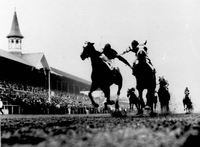미시간 주립대학 수의과대학의 대동물 임상파트의 수의사이자 박사인 Hilary Clayton은 말의 운동기에 대한 광범한 연구를 지속하여왔다. 그녀는 생물역학적 효율성에 대해 정의하기를 말이 섭취하는 음식물로부터 얻어지는 화학적 에너지를 운동이라는 기계적 에너지로 전환하는 작용이라고 하였다. 생물역학의 목표는 바로 음식물 섭취를 최소화 하면서 동물을 가능한 한 멀리 혹은 가능한 한 빨리 이동시키는 것이다(마치 연료효율이 높은 자동차처럼 말이다). 근육의 에너지를 사용할 필요 없이 탄성 좋은 스프링 역할을 하는 건이라는 독특한 구조를 사용하여 운동의 효율성을 높인다던지 하는 것도 생물역학적 효율성과 관계가 있다.
에너지 효율성이 높은 다리의 운동
말의 생물역학적 효율성을 높이는 방법의 하나는 바로 말이 다리를 앞으로 내어뻗는 방법이다. 에너지는 다리의 움직임을 가속하고, 지면에 착지하기 전 감속하기 위해 필요하다. 말이 바닥이 움직이는 트레드밀에서 운동을 하고 있다고 가정을 해보면, 말의 다리는 트레드밀 벨트에 의해 발굽이 뒤로 밀려남에 따라 움직이지 않는 말의 몸체 아래에서 뒤로 밀려나게 된다. 그리되면 말은 트레드밀의 움직임에 반하는 방향으로 바닥을 차내며, 공기중에서 다리를 가속시켜 고정된 몸을 따라잡은 후 다시 트레드밀 벨트에 착지하기 전의 속도 정도로 감속하게 된다.
그러나 말이 트레드밀이 아니라 지면에서 운동을 하고 있다고 가정을 해보자. 말의 발굽이 지면에 있을 때 말의 발굽은 정지해 있으나 몸체는 앞으로 계속해서 움직이려고 할 것이다. 그리고 말은 지면에 착지하기 전에 다리 전체를 몸체가 움직이는 것보다 더 빠르게 앞으로 뻗는다.
앞으로 나아가고 다리를 뻗기 위해 말이 사용하는 에너지는 아주 중요한 요소이다. 다리를 뻗는 스윙기의 중간 시점에 말의 발굽은 마체 전체가 움직이는 속도의 약 2배보다 좀 더 빠른 속력으로 움직인다. 이를테면, 말이 시속 64Km로 달릴 때 발굽은 스윙기에 시속 약 160Km로 움직인다고 보면 된다. 이는 말의 몸 전체가 움직이는 속력을 포함하는 수치이다. 발굽이 움직이는 속도에는 2개의 요소가 존재한다. 하나는 발굽이 연결된 몸체가 움직이니 따라서 움직이는 속도이고 나머지 하나는 앞으로 다리를 뻗음에 따라 말이 꼭 만들어내야 하는 속도이다. 경주 중 습보에서 말은 초당 2.5보를 달려야한다. 이는 한개 굽이 매초 10번의 가속과 감속을 반복해야 한다는 것을 의미한다.
관성의 순간
말이 다리를 뻗을 때의 에너지에 영향을 미치는 몇 개의 요소가 있다. 전진 운동에 대한 다리의 저항은 다리의 관성의 순간(무언가가 가속에 저항하려고 하는 성질)에 의해 결정된다. 다리를 뻗기 위해 필요한 에너지는 관성에 의한 다리의 회전에 대한 저항에 의해 결정된다는 이야기이다. 관성의 순간은 다리의 질량과 선회점에 질량이 어떻게 분포하는지에 의해 결정된다.
이는 마치 야구 방망이를 휘두르는 것과 같은 이치이다. 가느다란 쪽을 집어 들면 두껍고 무거운 쪽을 잡을 때보다 스윙하기가 더 힘이 든다. 이는 중력의 중심이 야구 방망이의 두꺼운 쪽에 위치하기 때문이다. 중력의 중심을 선회축인 팔에 가까이 두면 둘수록 더 먼 쪽에 무게가 가벼워지므로 스윙하기가 더 쉬워지는 것이다.
이와 같은 이론이 말의 다리에도 똑같이 적용된다. 몇 개의 형태학적인 특징으로 볼 때, 말의 중력의 중심은 다리의 위쪽에 위치하며 이는 선회점과 가깝다. 그러므로 모든 큰 근육은 다리의 상부에 존재하고, 질량이 가벼운 구조-건이나 뼈는 완관절, 비절 아래에 위치하는 것이다. 앞다리의 가장 큰 근육은 어깨나 주관절 부분에 위치하고, 작은 근육은 전완에 위치한다. 무릎 아래에는 본질적으로 근육은 존재하지 않는다.
건의 반동
말의 몸의 생물역학적인 또 다른 구조는 바로 다리의 근육들이 길고 탄성이 좋은 건으로 잘 진화되었다는 것이다. 이러한 건은 무게가 다리에 가해졌을 때 늘어난다. 그리고 무게가 다리로부터 제거되면 마치 용수철처럼 다시 줄어든다.
탄성은 어떤 물체가 당기거나 밀리고 혹은 꼬인 후 다시 제 모양으로 돌아가는 성질을 말한다. 건은 탄력이 건에 작용하면 늘어났다가 다시 줄어드는 성질이 있다. 늘어나는 과정에서 기계적인 에너지를 저장하고, 반동기에는 이 에너지를 방출한다. 탄성에너지는 무게가 가해질 때 저장되고, 늘어날 때 방출된다. 방출된 에너지는 근육을 움직일 때 사용되기 보다는 관절을 움직일 때 사용된다. 이는 근육이 수축할 때 에너지가 소비되는 것을 막고 말의 움직임의 효율성을 증가시키는데 기여한다.
밀어내기
다리가 지면에 있을 때 말은 다리의 근육을 이용해 굽이 지면을 더 잘 차 낼 수 있도록 굽에 지렛대를 형성한다. 만약 속도의 궁극적인 결정 요인을 정의한다면 이는 더 빨리 말의 다리를 앞으로 뻗는 것이 아니라 땅을 더 세게 밀어내는 능력일 것이다.
말의 뒷다리는 추진력의 대부분을 제공하는 역할을 한다. 그리고 앞다리는 뒷다리의 역할을 보조하는 역할을 하게 된다.
운동의 종류에 따라 앞다리의 역할은 달라지게 마련이다. 이를테면 경주마는 더 많은 운동을 위해 앞다리를 지면을 밀어내는 데에 사용한다.
뒷다리의 뒤쪽에 존재하는 근육, 이를테면 둔부 신근, 오금근 등은 뒷발굽이 지면을 밀어낼 때 뒷다리를 뒤로 당기는 데에 아주 유용한 근육들이다.
생물역학에 관한 연구
생물역학에 관한 어떤 연구는 트레드밀상에서 이루어지고 또 어떤 연구는 지면상에서 이루어진다. 미시간 주립대학의 Clayton 박사는 캘리포니아 주립 다기능 대학의 연구팀과 각기 속도를 달리하였을 때의 속보 및 언덕을 올라갈 때와 내려갈 때의 속보가 말의 운동에 미치는 영향에 대해 공동 연구하였다.
속도를 달리 하였을 때의 속보는 말이 다리를 움직이고, 지면을 밀어내고, 특정 관절에 가해지는 스트레스, 다리에 가해지는 진동에도 영향을 미친다.
상기 학자들은 말의 다리와 등에 패드를 이용하여 일정한 무게를 가하였을 때의 영향에 대하여도 보고한바 있는데 말의 다리에 무게를 가하였을 때 보다는 등에 무게를 가하였을 때 말의 움직임에 미치는 영향이 더 적다고 하였다.
움직이지 않는 안장이나 패드가 기승자의 일정하지도 않고 고정도 되어 있지 않은 무게보다 말에게 미치는 영향이 더 적다고 한다. 말은 무게가 어느 위치에 가해질 것인지 예상할 때 훨씬 더 적응하기가 쉽다.
어떤 학자는 발굽이 지면을 밀어내는 힘을 측정하기 위해 포스 플레이트를 사용하기도 한다. 이 때 포스(힘)는 말의 체중과 근육의 운동 두 가지 모두를 반영한다. 같은 말이라 하더라도 지면을 밀어낼 때 근육을 더 많이 사용하여 더 세게 밀어낸다면 속보 시 더 높이 떠올라 착지할 때 더 많은 힘으로 바닥을 차낼 수 있다는 말이다.
발굽이 지면에 닿은 직후 발생하는 충돌과 진동도 말의 체형, 행동, 속도, 지면의 종류 등에 영향을 받는다. 바닥이 딱딱하면 할수록, 속도가 빠르면 빠를수록 충돌하는 힘도 더 커진다.
오늘의 교훈
말을 강도 높게 훈련시킬 마주가 말 다리의 기능이 어떻게 작용하는지, 또한 말의 생물역학적인 구조, 보조적인 편자, 부츠, 안장 등이 운동에 미치는 영향에 대해 정확하게 이해를 한다면, 경주마를 보다 더 건강하게 유지하고, 보다 더 오래 곁에 둘 수 있게 될 것임에 분명하다.
경주마보건원 대리 정효훈
<출처:www.thehorse.com , Biomechanical Efficiency, October 2005>








